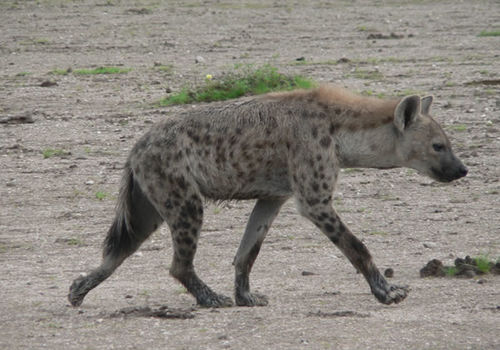
Spotted hyena
Crocuta crocutaSpotted hyena
Introduction: Although hyena have a reputation of being scavengers, they are actually very efficient hunters with very powerful jaws. This is perhaps best appreciated when an individual is seen running from a kill carrying the hind leg of a wildebeest or other heavy section of a carcass, high off the ground. Adult hyenas can run at speeds of up to 60km/hr. Female hyena are larger than males and have an erectile clitoris (which makes it virtually impossible to distinguish between the sexes). Clans of hyena are led by dominant females. The spotted hyena (Crocuta crocuta) have particularly heavy fore quarters with relatively lighter hind quarters. This is over emphasized by tucking their tails between their legs when they are running away, giving the impression of having sloping backs.
Distinguishing between the spotted hyena from the brown hyena can be made easier by identifying the following differences:
The spotting on the body of the spotted hyena is usually visible, except in very old individuals.
It has more rounded ears as opposed to the pointed ears of the brown hyena.
The spotted hyena has a shorter, less shaggy coat.
Both spotted and brown hyenas garner very little notice from prey species when walking or lying down. It is only when one runs towards them, that their intended prey is alerted.
Distribution: Once widespread throughout Namibia, spotted hyenas can now mainly be found in Etosha National Park, Kaokoland, the Caprivi Strip, Kavango and Bushmanland areas. Other small populations also exists in the Namib Desert, and within the Skeleton Coast National Park.
Diet: Food is dictated largely by what is available, but adults and calves of wildebeest and zebra are the main target. They are well-known for scavenging on most meat.
Colouring: It is greyish-drab to rufous in body colour and is covered with large spots
Breeding: Between 1-4 young are born at any time during the year (with a peak in late summer) after a gestation period of ± 3 months.
Size: The spotted hyena stands around 80cm at the shoulder and females can weigh between 56 - 80 kg, on average heavier than the male, who weighs between 46 - 79 kg. Both male and female are around 1.5m long.
Klein Windhoek

